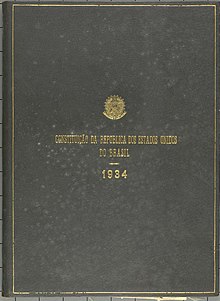| Brazilian Constitution of 1934 | |
|---|---|
 Cover of a signed copy of the 1934 Constitution of the Republic of the United States of Brazil held by the National Archives | |
| Overview | |
| Jurisdiction | United States of Brazil |
| Date effective | July 16, 1934 |
| Author(s) | National Congress of Brazil Constituent Assembly of 1933 |
| Supersedes | Brazilian Constitution of 1891 |
The Brazilian Constitution of 1934, promulgated on July 16 by the National Constituent Assembly of 1932, was created "to organize a democratic regime that ensures the unity, freedom, justice and social and economic well-being of the nation," as stated in its preamble. Among Brazilian constitutions, it lasted the shortest: it was officially in force for one year, when it was suspended by the National Security Law. It was significant for institutionalizing the reform of Brazil's political and social organization, establishing Brazilian democracy - with the inclusion of the military, the urban middle class, workers and industrialists.[1]
The 1934 Constitution was a possible consequence of the Constitutionalist Revolution of 1932, when troops from São Paulo, including volunteers, Army soldiers and the Public Force, fought against the Brazilian Army. It was also a result of tenentism and the 1930 Revolution, when dissident soldiers supported by part of the population overthrew the First Republic.[1]
In 1934, the National Constituent Assembly, convened by the Provisional Government of the 1930 Revolution, drafted and promulgated Brazil's second republican constitution. The document reformulated the organization of the First Republic and made progressive changes, but it was short-lived: in 1937, a ready-made constitution was signed by Getúlio Vargas, converting the president into a dictator and the revolutionary state into an authoritarian one.[2]
- ^ a b "Constituição de 1934". UOL. Retrieved 2023-10-09.
- ^ Andrade, Jose Carlos (2018-07-12). "História Hoje: Há 84 anos, era promulgada a segunda Constituição da República do Brasil". Radio Agência. Retrieved 2023-10-09.